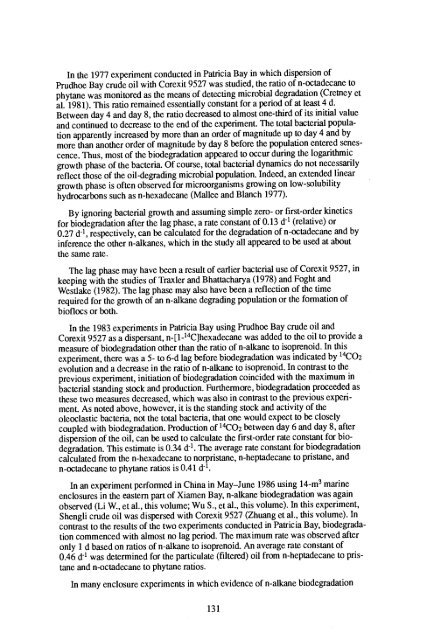Marine Ecosystem Enclosed Experiments - International ...
Marine Ecosystem Enclosed Experiments - International ...
Marine Ecosystem Enclosed Experiments - International ...
Create successful ePaper yourself
Turn your PDF publications into a flip-book with our unique Google optimized e-Paper software.
In the 1977 experiment conducted in Patricia Bay in which dispersion of<br />
Prudhoe Bay crude oil with Corexit 9527 was studied, the ratio of n-octadecane to<br />
phytane was monitored as the means of detecting microbial degradation (Cretney et<br />
al. 1981). This ratio remained essentially constant for a period of at least 4 d.<br />
Between day 4 and day 8, the ratio decreased to almost one-third of its initial value<br />
and continued to decrease to the end of the experiment. The total bacterial population<br />
apparently increased by more than an order of magnitude up to day 4 and by<br />
more than another order of magnitude by day 8 before the population entered senescence.<br />
Thus, most of the biodegradation appeared to occur during the logarithmic<br />
growth phase of the bacteria. Of course, total bacterial dynamics do not necessarily<br />
reflect those of the oil-degrading microbial population. Indeed, an extended linear<br />
growth phase is often observed for microorganisms growing on low-solubility<br />
hydrocarbons such as n-hexadecane (Mallee and Blanch 1977).<br />
By ignoring bacterial growth and assuming simple zero- or first-order kinetics<br />
for biodegradation after the lag phase, a rate constant of 0.13 V (relative) or<br />
0.27 d-1, respectively, can be calculated for the degradation of n-octadecane and by<br />
inference the other n-alkanes, which in the study all appeared to be used at about<br />
the same rate.<br />
The lag phase may have been a result of earlier bacterial use of Corexit 9527, in<br />
keeping with the studies of Traxler and Bhattacharya (1978) and Foght and<br />
Westlake (1982). The lag phase may also have been a reflection of the time<br />
required for the growth of an n-alkane degrading population or the formation of<br />
bioflocs or both.<br />
In the 1983 experiments in Patricia Bay using Prudhoe Bay crude oil and<br />
Corexit 9527 as a dispersant, n-[l-14C]hexadecane was added to the oil to provide a<br />
measure of biodegradation other than the ratio of n-alkane to isoprenoid. In this<br />
experiment, there was a 5- to 6-d lag before biodegradation was indicated by 14CO2<br />
evolution and a decrease in the ratio of n-alkane to isoprenoid. In contrast to the<br />
previous experiment, initiation of biodegradation coincided with the maximum in<br />
bacterial standing stock and production. Furthermore, biodegradation proceeded as<br />
these two measures decreased, which was also in contrast to the previous experiment.<br />
As noted above, however, it is the standing stock and activity of the<br />
oleoclastic bacteria, not the total bacteria, that one would expect to be closely<br />
coupled with biodegradation. Production of 14CO2 between day 6 and day 8, after<br />
dispersion of the oil, can be used to calculate the first-order rate constant for biodegradation.<br />
This estimate is 0.34 d71. The average rate constant for biodegradation<br />
calculated from the n-hexadecane to norpristane, n-heptadecane to pristane, and<br />
n-octadecane to phytane ratios is 0.41 d71.<br />
In an experiment performed in China in May-June 1986 using 14-m3 marine<br />
enclosures in the eastern part of Xiamen Bay, n-alkane biodegradation was again<br />
observed (Li W., et al., this volume; Wu S., et al., this volume). In this experiment,<br />
Shengli crude oil was dispersed with Corexit 9527 (Zhuang et al., this volume). In<br />
contrast to the results of the two experiments conducted in Patricia Bay, biodegradation<br />
commenced with almost no lag period. The maximum rate was observed after<br />
only 1 d based on ratios of n-alkane to isoprenoid. An average rate constant of<br />
0.46 d-1 was determined for the particulate (filtered) oil from n-heptadecane to pristane<br />
and n-octadecane to phytane ratios.<br />
In many enclosure experiments in which evidence of n-alkane biodegradation<br />
131
















